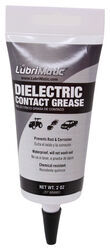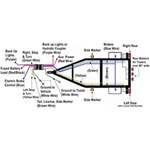
Troubleshooting Blown Fuses on Running Light Circuit of 7-Way Socket
Question:
Recently brought a brand new enclosed trailer, shortly after I realized that the side markers/license plate/tail lights werent working other functions OK. I looked at a wiring diagram and pin layout and realized those are all off the same pin so I checked the fuse for them which was a 15a from the factory. It WAS infact blown so I replaced it. Within a couple seconds of turning it back on it popped again. I unplugged the trailer and replaced it once more, when I turned it back on The fuse was fine which lead me to think there was a short in the trailer wiring I then put my meter on the plug of the trailer from the tail light/sidemarker pin to the common/ground pin and read high resistance no short I thought ok maybe it shorted with another circuit, I proceded to check it from the tail light/sidemarker pin to the rest of the 6 remaining pins. None read low resistance. I then went from every pin to every pin and the only combination I found that was low resistance was from electronic brake pin to ground which I believe It SHOULD be? With everything checking out on the trailer I think I moved on to the trucks receptacle. With the fuse replaced and the truck on I had the brake pedal compressed, my hazards on, and my running lights on as well. I took my meter this time to get a voltage reading. Comm/ground - brakes/turn signals intermittent 15VDC Comm/ground - trailer brakes 0VDC ? Comm/ground - sidemarkers/running lights 15VDC Truck seems to be putting consistent power to the stabs but its 15VDC where I anticipated 12VDC? *plugged the trailer into another newer truck and the trailer lights worked fine. Im at a loss. Could a ground issue on the truck cause a problem like this? If not what might?
asked by: Drew
Expert Reply:
The easiest way to troubleshoot your trailer lighting functions is when it is not connected to the tow vehicle. Apply 12V power from the truck's battery or a well-charged spare if you have in the garage directly to the contacts on the trailer plug. Direct power input to the trailer plug lets you test the trailer running/clearance/license plate light function in isolation, without any possible interaction with the vehicle. A set of jumper cables and two short lengths of 10- or 12-gauge wire are all you need.
Apply the battery ground to the ground contact on the 7-way plug and then apply the +12V wire to the contact for the running light circuit. Please refer to the linked photo. If the various lights that share this circuit (tail, clearance and license plate lights) all function with this direct power input then you know to move on to the vehicle.
You mention successfully testing the trailer with a newer truck. Since this suggests you have an older truck then you might focus on the 7-way and the connector leading to it.
What can happen is that over time corrosion can begin on the inside of the vehicle socket, or within the connector that plugs in to the back of it. Often this starts with nothing more than a little trapped water and/or dirt but over time it can develop into a corrosive build-up that can bridge adjacent circuits and cause a dead short that blows a fuse. Note the +12V trailer power circuit is adjacent to the running light circuit. To make matters worse, sometimes this issue can be intermittent; the force of inserting or removing the plug can cause or correct that short. It is often impossible to see this corrosion from the outside of the socket or plug.
I suggest disconnecting the wiring from the back of the 7-way and carefully inspecting the interior of both the 7-way socket and the connector on the harness. There are spray-on type electrical contact cleaners on the market (Caig makes good ones) that can help dissolve corrosion but sometimes it will be necessary to manually clean them out or simply replace them. Start at the 7-way and move forward as far as you can to check for any such issue.
Such connections can be protected with an application of dielectric grease such as # 11755 which will block entry of moisture and contaminants.

Product Page this Question was Asked From
Dielectric Grease for Electrical Connectors, 2 oz.
- Accessories and Parts
- Trailer Wiring
- Wiring
- Dielectric Grease
- LubriMatic
more information >
Featured Help Information
Miscellaneous Media

Continue Researching
- Search Results: 12 volt breakaway battery
- Shop: Trailer Wiring
- Shop: 40 Ft 5-Way Trailer Wiring Harness - Wishbone Style - 30" Ground - 5' Auxiliary Wire
- Search Results: trailer tubing
- Article: Trailer Wiring Diagrams
- Shop: 7-Way Molded Trailer Wire Connector - 3' Long
- Shop: Hopkins 5-Way Flat Trailer Connector w/ LED Test Lights - Trailer End - 24"
- Shop: ONE LED RV Combination Tail Light w/ License Plate Bracket - 4 Function - 1 Diode - Driver Side
- Shop: RV Tail Light - Stop, Tail, Turn, License Plate - Rectangle - Red Lens - Driver Side - White Base
- Shop: Replacement Screen Frame with Screen for Ventline Ventadome Manual Lift Roof Vents - Birch White
- Q&A: How To Re-Wire Your Boat Trailer's 5 Way Wiring And Install New LED Lights
- Q&A: Diagnosing, Locating and Repairing Trailer Ground Problem
- Q&A: No Power at 12 Volt Pin In 7-Way on a 2008 Toyota Tundra
- Shop: Dielectric Grease for Electrical Connectors, 2 oz.
- Q&A: Possible Causes for Dim Trailer Lights
- Video: Hopkins Trailer Breakaway Kit Review
- Search Results: 7 blade connector
- Video: Review of Hopkins Trailer Wiring - Trailer Connectors - HM20041
- Video: Curt Soft Trac I Trailler Breakaway Kit Review
- Video: Hopkins Engager Push-To-Test Trailer Breakaway Kit Review
- Video: Bright Way Push-to-Test Trailer Breakaway Kit Review and Installation 3802308
- Video: Bright Way Trailer Breakaway Kit with Switch Review
- Video: Hopkins Wiring - Trailer Connectors - HM20087 Review
- Article: Curt Echo Full Review
- Shop: Brake Controller
- Q&A: How to Determine if Trailer 7-Way is Upside Down for Determining Pin Out
- Q&A: Testing a Vehicle Side 7-Way Trailer Connector for Proper Function
- Q&A: 12 Volt Accessory 7-Way Circuit Fuse Location
- Search Results: sway control
- Search Results: sway control bar






